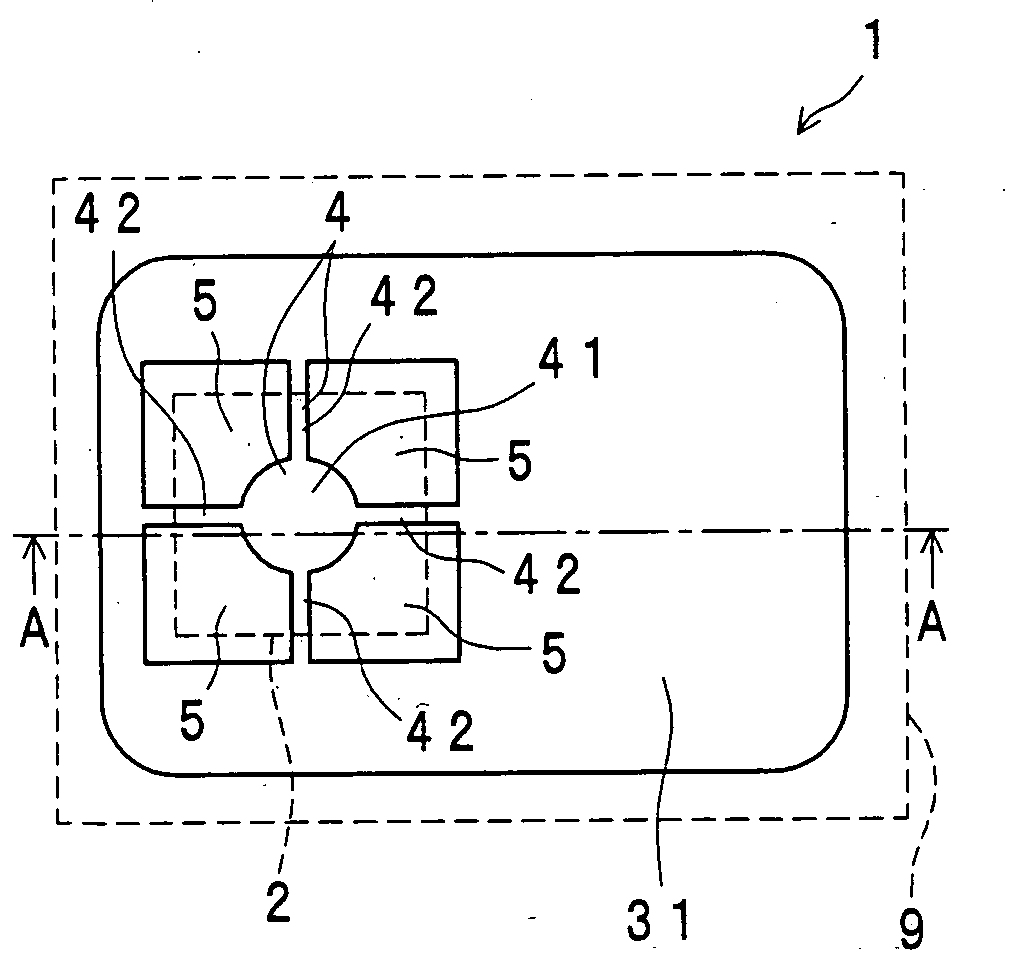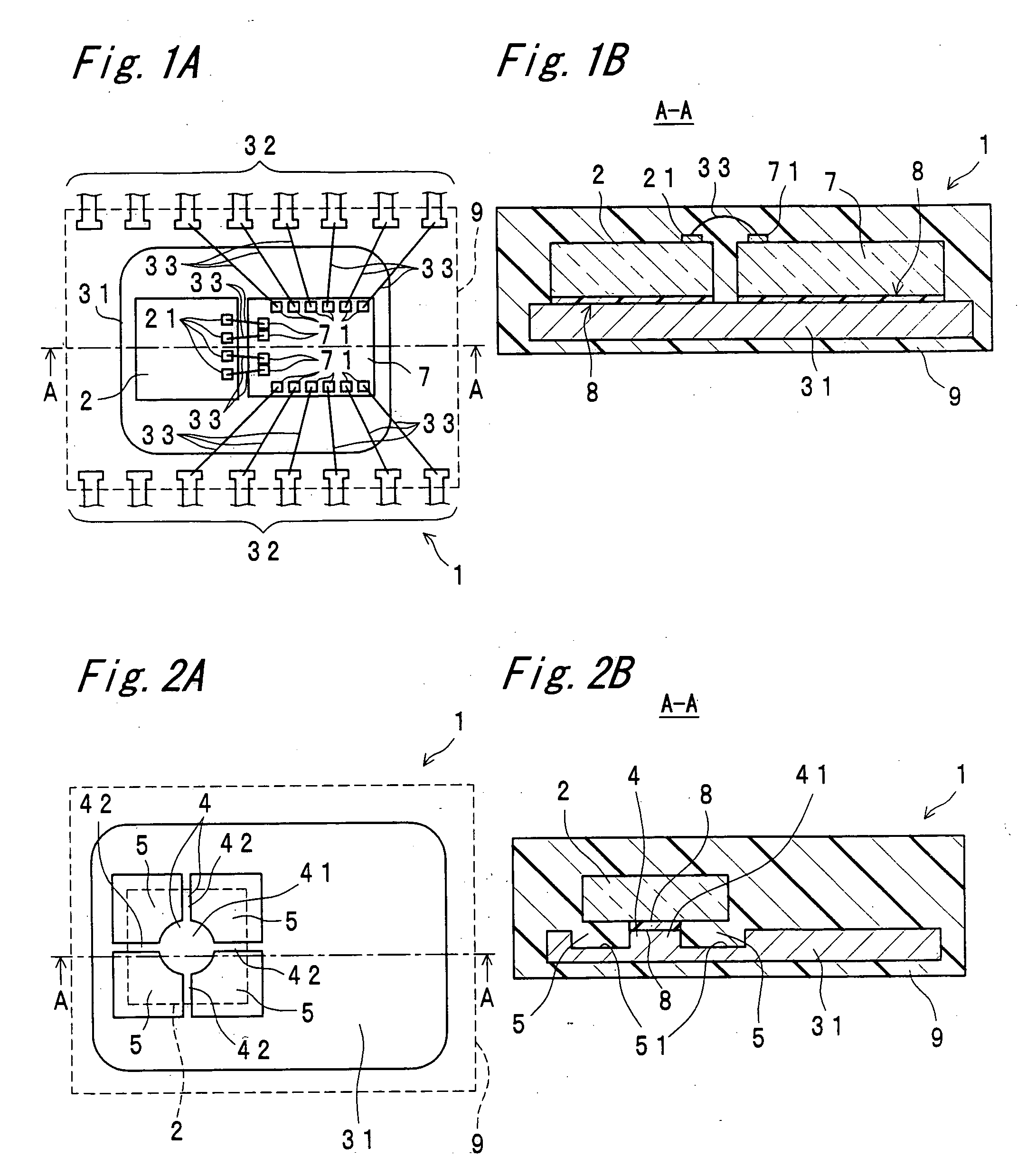Semiconductor micro device
a semiconductor and micro-chip technology, applied in the direction of turning-sensitive devices, acceleration measurement using interia forces, liquid/fluent solid measurement, etc., can solve the state and distribution of thermal strain potentially imposed on the silicon structure chip, the structure chip erroneously operates, and the thermal strain of the structure chip is more complex. , to achieve the effect of reducing the area of contact, increasing the thermal strain of the structure chip, and reducing the thermal strain potentially imposed on the structure chip
- Summary
- Abstract
- Description
- Claims
- Application Information
AI Technical Summary
Benefits of technology
Problems solved by technology
Method used
Image
Examples
first embodiment
[0056]FIGS. 1A and 1B show schematic views of a resin-encapsulated semiconductor micro device 1. A sensor chip 2 as a silicon structure chip having a movable portion, and a semiconductor chip 7 (application specific integrated circuit (ASIC)) are die-bonded on a die pad 31 of a lead frame. The sensor chip 2 and the semiconductor chip 7 are electrically connected to each other by wires 33 through bonding pads 21 and 71 provided on the surfaces of the sensor chip 2 and the semiconductor chip 7 respectively. Further, the semiconductor chip 7 is electrically connected by wires 33 to inner leads 32 of the lead frame. The sensor chip 2, the semiconductor chip 7, the die pad 31, and the inner leads 32 are molded of a resin encapsulating material 9 and thereby hermetically sealed from the outside.
[0057]FIG. 2A is view of a first embodiment of the semiconductor micro device according to the present invention. More specifically, FIG. 2 mainly shows configurations of a sensor chip 2 and a die...
second embodiment
[0071]FIG. 4A is view of a second embodiment of the semiconductor micro device according to the present invention. More specifically, FIG. 4A mainly shows configurations of a sensor chip 2 and a die pad 31, wherein a semiconductor chip 7 and inner leads 32 are not shown. The sensor chip 2 used in the present embodiment is shaped to be electrically communicable with another semiconductor chip 7 by wire bonding. In the shown sensor chip 2, four bonding pads 21 for wire bonding are formed on the upper surface of the sensor chip 2 along one side of the rectangle whereon the sensor chip 2.
[0072] A contact portion 4 for supporting the sensor chip 2 and a recess portion 5 formed by etching about half the thickness of the die pad 31 are formed on the surface of the die pad 31.
[0073] The contact portion 4 is constituted of two portions. One is a pad support portion 43 that supports a bottom portion of one side (right side of the chip, as viewed in FIG. 4A), along which the bonding pads 21 ...
third embodiment
[0089]FIG. 7A is view of a third embodiment of the semiconductor micro device according to the present invention. More specifically, FIG. 7A mainly shows configurations of a sensor chip 2 and a die pad 31, wherein a semiconductor chip 7 and inner leads 32 are not shown. The sensor chip 2 used in the present embodiment is shaped to be electrically communicable with another semiconductor chip 7 by wire bonding, as in the case of FIG. 1A. In the shown sensor chip 2, four bonding pads 21 for wire bonding are formed on the upper surface of the sensor chip 2 along one side of the rectangle whereon the sensor chip 2.
[0090] A contact portion 4 for supporting the sensor chip 2 and a recess portion 5 formed by etching about half the thickness of the die pad 31 are formed on the surface of the die pad 31.
[0091] The contact portion 4 is constituted of two portions. One is a pad support portion 43 that supports a bottom portion of one side (right side of the chip, as viewed in FIG. 7A), along ...
PUM
| Property | Measurement | Unit |
|---|---|---|
| thermal strain | aaaaa | aaaaa |
| resistance | aaaaa | aaaaa |
| acceleration | aaaaa | aaaaa |
Abstract
Description
Claims
Application Information
 Login to View More
Login to View More - R&D
- Intellectual Property
- Life Sciences
- Materials
- Tech Scout
- Unparalleled Data Quality
- Higher Quality Content
- 60% Fewer Hallucinations
Browse by: Latest US Patents, China's latest patents, Technical Efficacy Thesaurus, Application Domain, Technology Topic, Popular Technical Reports.
© 2025 PatSnap. All rights reserved.Legal|Privacy policy|Modern Slavery Act Transparency Statement|Sitemap|About US| Contact US: help@patsnap.com



